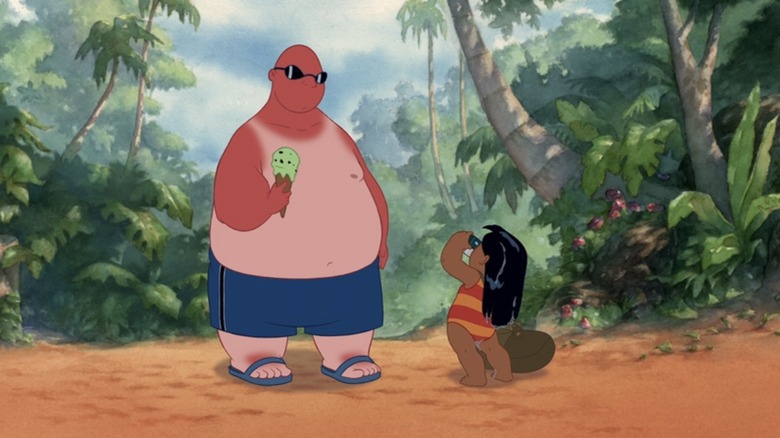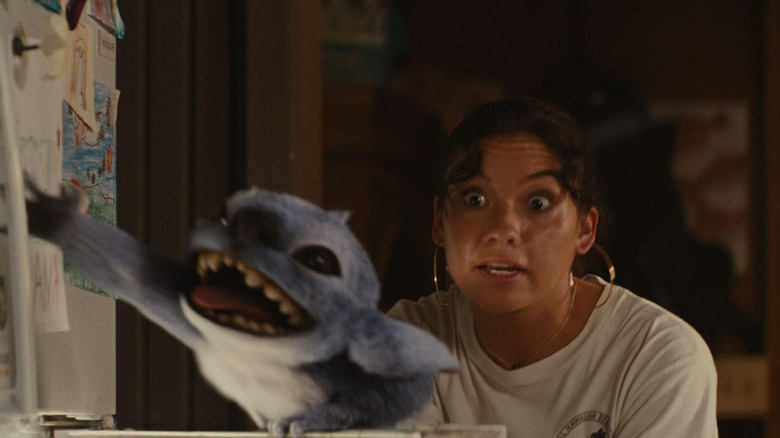“Lilo & Sew” creator and co-director Chris Sanders randomly selected Hawaii for the movie’s setting after lately vacationing there, nevertheless it ended up being the right place for his story of displacement and belonging. The filmmakers behind “Lilo & Sew” genuinely revered Hawaiian tradition and cared about representing it pretty, making frequent analysis journeys to review all facets of Pacific Islander residing.
Commercial
“There was a whole lot of cautious commentary of the parents we met, and attempting to channel that regular-life-in-Hawaii really feel into the film in order that it did not come throughout as simply folks in hula skirts standing on a seashore, like Blue Hawaii,” co-writer/co-director Dean DeBlois defined to Vulture. Because the filmmakers had been, in any case, two white males, that they had a duty to painting the Native expertise with reverence, which Sanders rightfully acknowledges:
“Dean and I’ve no enterprise telling a Hawaiian story. You possibly can inform tales like that, however you then discover individuals who do have a enterprise there. So we reached out to as many individuals as we may that lived there.”
They carefully examined luau dancers’ each sleek glide and heard the hardships of a younger lady who impressed Nani’s resilient perspective. Though nonetheless inside the confines of a family-friendly Disney film, the animated “Lilo & Sew” wasn’t afraid to acknowledge — nonetheless subtly — Hawaii’s difficult historical past.
Commercial
Regardless of being co-written by a Native Hawaiian, Chris Kekaniokalani Vivid (whose mom led the Kamehameha Colleges Youngsters’s Refrain on the soundtrack), the brand new model fully erases this cultural commentary. The live-action “Lilo & Sew” adaptation coasts purely on the aesthetics of lovely seashores, hula dancing, and browsing.
Hawaii’s vacationer downside
The remake fully erases one in all Lilo’s quirks, which held a deeper that means about colonialism. Though a serious a part of the financial system, tourism in Hawaii is a matter as a result of it inflates housing costs and destroys sacred lands. The animated Lilo likes to take images of the pudgy, sunburnt vacationers. She gawks at them like they might do to her as a little bit Native lady.
Commercial
This curiosity would have resonated extra if the scene the place Lilo encounters a number of racist vacationers hadn’t been deleted. One pronounces Mahalo incorrectly, one other harshly yells to Lilo, “Communicate English?” and one other shouts, “Oh look, an actual Native!” when she walks by. All these white American vacationers are trampling on land they stole and don’t deal with the individuals who truly stay there with any courtesy. Their solely concern is what they’ll pilfer for their very own pleasure.
Lilo pranks the vacationers on the day of tsunami siren testing. She launches right into a macabre monologue in regards to the “massive, hundred-foot waves” which might be coming earlier than the siren blares. “Vacationers, put together to die!” Lilo screams as they scramble off the seashore. “Should you lived right here, you’d perceive,” she somberly concludes. It is a nice scene that not solely feedback on the Indigenous group’s marginalization, but additionally showcases Lilo’s morbid humorousness that mirrors Sew’s. Sadly, it was most likely too edgy for Disney to maintain.
Commercial
If the live-action remake already stretched the film to just about two hours, why not add this scene again in? As a substitute, it fully ignores something in regards to the vacationers. The one who drops his ice cream within the authentic is now turned into a Native Hawaiian, turning the second right into a gag relatively than a cultural critique. Lilo herself enjoys the scorching tubs at a flowery resort, framing tourism as enjoyable and handy.
‘Household means no one will get left behind’ … proper?
With exorbitant residing prices and hospitality jobs that do not present a residing wage, many Hawaiians battle to make ends meet or face homelessness. These systemic points intensify Nani’s struggles to lift Lilo when she’s nonetheless younger herself. Within the authentic movie, Nani strikes heaven and earth to maintain Lilo, however she’s dour and extremely frazzled within the live-action model.
Commercial
After which there’s the ending. Nani chooses to put Lilo in foster care together with her neighbor Tūtū whereas she attends school for Marine Biology in San Francisco. Some might discover this a welcome change, since it will be a short lived scenario and Nani is working towards a greater method to assist Lilo long-term. But it surely additionally makes little sense and contradicts the unique movie’s message about Ohana. Hawaii is an ideal place to review Marine Biology and Nani’s resolution perpetuates the romanticized American Dream, the place the solely method for Indigenous folks to have a greater life is to go away the island. It additionally undermines the painful historical past of the various Native youngsters the state faraway from their properties and infrequently positioned with white army households,
Commercial
Ohana means household. Household means no one will get left behind or forgotten — until you are a non-traditional one. Then the federal government must be concerned. In mild of present occasions, the place ICE continues to separate immigrant households, and households in Gaza are being devastated by army assaults, this could not be extra of a tone deaf message. The brand new “Lilo & Sew” is toothless as a result of Disney solely cares about promoting Aulani resort reservations. These live-action remakes might brag about showcasing range, but when it got here time to faithfully adapt one of many few Disney motion pictures that really cares about being inclusive, the studio fumbled.

